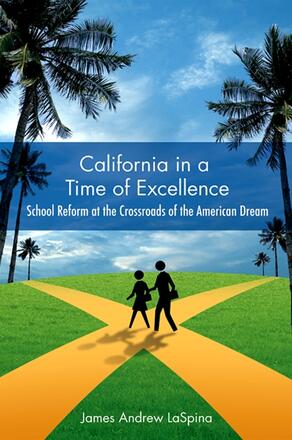
California in a Time of Excellence
School Reform at the Crossroads of the American Dream
Alternative formats available from:
Follows California’s efforts at reforming the public school system from 1983 to the present.
Description
California in a Time of Excellence follows the Golden State's efforts to reform its public school system from 1983 to the present. Beginning with progressive curriculum reform initiatives that were launched even before the National Commission on Excellence in Education (NCEE) issued A Nation at Risk in 1983, James Andrew LaSpina traces these reform efforts through recurring culture wars, major clashes of personality, and a conflict between the state's tradition of progressive educational policy and a culture of conservatism that colored much of the so-called Left Coast's history since the sixties. While the battles over curriculum reform in California reflect those at the national level, the political world surrounding this conflict reveals the enormous significance of the conflict and its implications for our national future.
James Andrew LaSpina is the author of The Visual Turn and the Transformation of the Textbook and a National Academy of Education/Spencer Postdoctoral Fellow.
Reviews
"California in a Time of Excellence provides a detailed 'nuts-and-bolts' analysis of the history of California's complicated educational politics and policy and comes at a welcome moment in which states and the nation are rethinking the foundation, funding, and future of educational excellence in the United States. " — H-Net Reviews
"…LaSpina makes an important contribution to our understanding of social studies curriculum reform history and policy … [and] provides a wonderful behind-the-scenes review of an important case of social studies curriculum development. " — Theory and Research in Social Education
"This account is an important contribution to the history of the dynamics of political policy and educational practice. A must read for public education reform history. " — CHOICE
"In the glory years of the 1950s and early 1960s, California's public educational institutions became the envy of the world. James Andrew LaSpina's remarkable book explains how that happened, and why it is going away. Readable and scholarly, a recommended work for all students, educators, and citizens alike who are interested in the history of American education, public policy, and the politics of reform. " — Kerwin Klein, University of California, Berkeley
"Do you want school reform? Of course you do. For the past century, Americans of every political stripe have demanded changes in our educational system. Strangely, however, scholars have neglected the political process of reform: the actors, organizations, debates, and decisions that shape actual policymaking in our schools. James Andrew LaSpina's eloquent book is a welcome exception. Paying close attention to the nitty-gritty politics of school reform, LaSpina provides a sobering account of its false starts and failed promise. But he also suggests other avenues of change, which could reconnect American schools to an older American dream. The dream isn't dead; it's lying dormant, waiting for a new generation of Americans to awaken it. " — Jonathan Zimmerman, New York University
"Using the last twenty-five years of California's history/social studies transformation as a lens, the major state reforms and politics are woven together masterfully from the capitol to the classroom. It is all here, including conflicting values, systemic reform, assessment, teacher development, and inequity. " — Michael W. Kirst, Stanford University